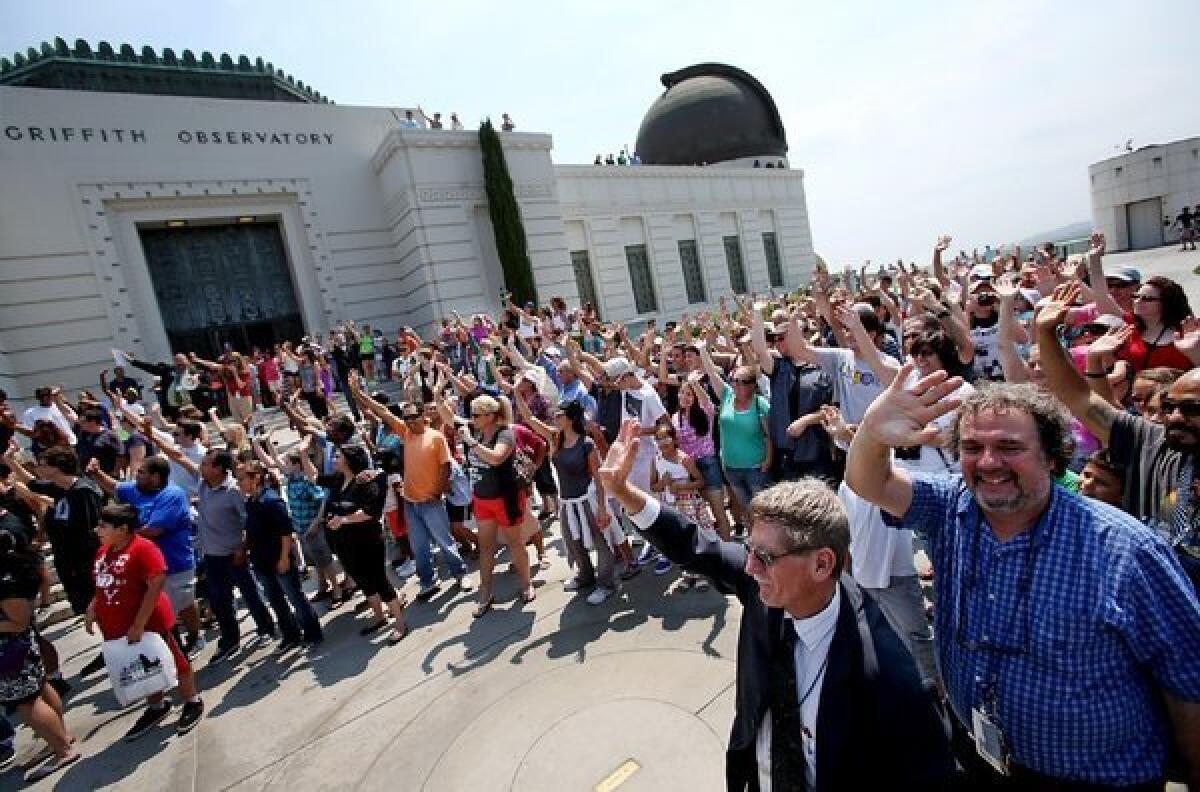Waving at Saturn is ‘humbling and awe-inspiring at the same time’

Griffith Observatory in Los Angeles was brimming with the usual summer crowd Friday, but few visitors knew that they’d be getting their photo taken from more than 898 million miles away. After learning that NASA’s Cassini spacecraft would be photographing the Earth from behind Saturn starting at 2:27 p.m., most decided they’d stick around for the interplanetary photo shoot.
“Wow,” said Michael Tritto, a tourist from Buffalo, N.Y. “I think it puts things in scale in terms of our relative position in the universe. Our whole world amounts to a speck.”
“It’s very humbling and awe-inspiring at the same time,” agreed Tritto’s wife, Virginia Riordan.
Griffith Observatory director Edwin Krupp said he didn’t expect too many visitors to know about the unusual event. Around 2:20 p.m., observatory staffers announced the photo shoot on a bullhorn and curator Laura Danly began organizing the crowd. She directed them to turn their smiles toward the southeast, where Saturn lies low on the horizon.
The observatory planned to stage a talk at 3 p.m. about discoveries Cassini has made during its 16-year mission.
Not everyone was of a mind to wax poetic about the long-distance picture-taking. “It’s fun, but it’s a gimmick,” said Izart, a systems engineer from Oregon who didn’t want to give his last name.
Awesome: Cassini will take Earth’s picture from 900 million miles away
Cassini will stitch together several photos to create a high-resolution mosaic image of the Saturn system. The planet will take up the bulk of the shot and Earth will appear as a 1.5-pixel blue dot peeking between Saturn’s rings.
The portion of the mosaic that includes Earth took about 15 minutes to shoot. So those who waved at Saturn had to exercise their smile muscles.
Cassini team members decided on the July 19 photo date after monitoring the spacecraft’s flight path to find a time when Saturn wouldn’t block Earth’s view. Cassini and the sun are on opposite sides of Saturn today, allowing the probe to capture an image of the ringed planet with remarkable clarity.
This opportune positioning allows scientists to study Saturn’s diffuse rings, especially its 620,000-mile-wide E ring. Scientists will compare the new mosaic image with one taken by Cassini in 2006 and look for signs of change.
The sunlight filtering through the rings will illuminate the tiniest of the ring’s particles, “whose width is comparable to the thickness of a hair,” Matt Hedman, a Cassini science team member, said in a statement.
Opportunities to take photos of Earth from elsewhere in the solar system are rare. There have been only two previous deep-space photographs. The first was taken from Neptune by the Voyager 1 spacecraft in 1990, and the other was taken by Cassini in 2006.
But Friday’s event was still a first of sorts, Scott Edgington, deputy project scientist for the mission at NASA’s Jet Propulsion Laboratory, explained during a webcast from the lab’s before the event. (Excited JPL staff members could be seen twirling hula hoops in the background.)
“This is the first time that we have told people that we are taking their picture, so that makes it very special – and gives us a chance to wave and hula hoop.”
[For the record, 5:53 p.m. July 19: An earlier version of this post misstated the name of Griffith Observatory director Edwin Krupp.]
Return to Science Now.






